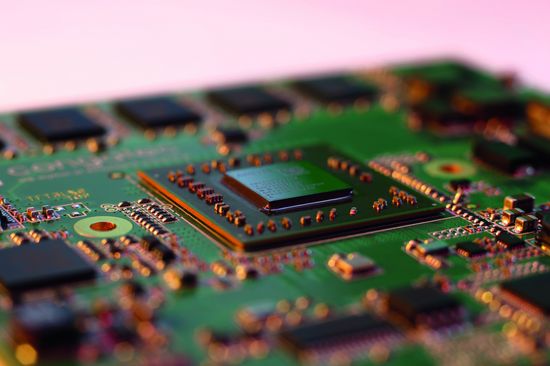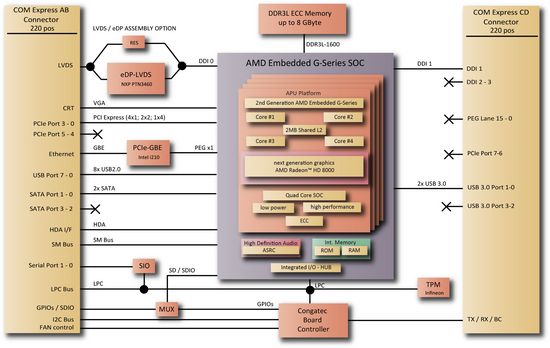
Embedded at the Point-of-Sale
Innovate your PoS, kiosk and vending systems for a brand new customer experience
The so-called retail sector is an extensive field of applications for em-bedded computers. But what does that mean? What are the special challenges and how can computer technology help? COM express, with the new AMD embedded G-series SoC, is proving itself to be the ideal platform for a wide variety of retail applications.
The term “retail” refers to the retail industry. While the mom-and-pop grocery store with personal service and advice is sadly a thing of the past, “personal” support is still required in today’s supermarkets. More and more often this is being handled by computer systems. The applications and requirements are quite varied. Printed placards are increasingly being replaced by digital signage equipment in the form of big screens. Special offers and advertising promotions can be updated within a few sec-onds, simultaneously and centrally controlled for thousands of branches of major retail chains. One of the first applications was implementing mobile computers on shopping carts, serving as shopping advisors and navigation systems in large stores. Price tags on shelves are updated electronically, synchronised with digital advertising and linked to the store’s inventory management system. Checkout systems are linked to the inventory management system as well, ensuring that the most current prices are used at all times and consistently maintaining an overview of the current stock levels. Even the scales are networked and can control several screens as well – when a customer buys asparagus, a suitable sauce from the product range can be promoted right away.
Computers Shorten Lines and Reduce Wait Times
While the first attempts at self-serve checkouts have not gained much acceptance in this country as of yet, they will become much easier to use in the future as modern stock recording systems such as RFID are implemented. This technology can capture all products in the shopping cart without having to take them out. Acceptance in our region will improve as a result, and line-ups at the checkouts will be a thing of the past.
Not only the sale, but also the return of refundable containers, for example, is con-trolled by embedded computer technology. The automated return machines used in large numbers require a lot of control technology, for example to inspect visual characteristics such as the logos of the various deposit systems or for weighing, pressing and storing the used containers. Numerous current computer technologies are used here: from graphical user guidance via touch screen, which requires a fast video controller, to the analysis of video data which demands a lot of computing power. All of this has to happen in a matter of seconds or the customer, exasperated, goes to the competition.
The shopping experience is becoming more and more important as a competitive edge. Viewed as a whole, a modern supermarket nearly resembles a networked super-computer. There is a lot that would not be possible without embedded computer systems operating in the background with new possibilities opening up every day.
All of these applications require specialised and highly reliable computer systems. In times of rising energy costs, these systems also need to be as efficient as possible. Modern processor technologies such as the new embedded G-series SoC from AMD (Figure 1) offer excellent performance per watt and flexible load sharing between the CPU and GPU. This makes the module based on the G-Series SoC an excellent choice for cost-sensitive visualisation and control applications – which is one of the key re-quirements in the retail sector.
Computer Modules for Adaptable Systems
In order to offer the optimum computing and graphics performance for the various applications, while also providing the respective special interfaces, computer modules, such as COM express, are oftenused. A special carrier board is developed for each application, equipped with a slot for the embedded computer in the form of the COM express module.
The conga-TCG (Figure 2) is particularly well suited in this context: a compact COM express
With the conga-TCA, the VGA, single/dual-channel LVDS with 18/24-bit, as well as DisplayPort 1.2 and DVI/HDMI 1.4a are executed by the integrated GPU and make it possible to directly control two independent displays (Figure 3). Multistream is also supported by DisplayPort 1.2 in order to control up to two displays per graphics port in daisy-chain mode. This is ideal for all graphics-heavy applications, e.g. for digital signage. The integrated AMD-Radeon graphics with Universal Video Decoder 4.2 creates smooth processing of BluRay with HDCP (1080p), MPEG-2, HD and DivX (MPEG-4) videos support DirectX 11.1 and OpenGL 4. With the open computing language OpenCL 1.1, computing-intensive tasks can be reassigned to the graphics processor with high parallelism. The analysis of video data, e.g. per OpenCL programming, can be processed fully and extremely quickly by the graphics engine since such tasks can be completed very well in parallel by the numerous execution units in the GPU. For such applications, the integrated GPU via OpenCL APIs provides a computing performance of up to 256 GFLOPs.
Fanless - Thanks to Low Power Consumption
The low power aspect of the new SoCs also makes fanless designs possible. This not only makes the systems quieter, but also more reliable since error-prone mechanical components such as fans can be eliminated. Sophisticated power management has a positive impact in the case where there are wait times in the application. This is a frequent occurrence in the retail sector, for example early in the morning when few empty containers are being returned. CPU state C6 “deep power down” is available on the multimedia engine as well, making it possible to further reduce power consumption without impairing ease of use since the computer needs less than a millisecond in order to switch from energy saving mode to full computing power.
The conga-TCG highlights its versatility with a broad performance range. Currently congatec offers a total of four x86 processors with the AMD embedded G-series SoC platform. They range from the AMD GX-210JA 1.0 GHz dual-core with 6-watt TDP to the AMD GX-420CA 2.0 GHz quad-core with 25-watt TDP.
Battery management of the conga-TCG is integrated in the firmware and the congatec board controller supports the straightforward implementation of mobile systems, for example those required for applications directly on the shopping cart. With the additional smart battery manager conga-SBM3, up to two batteries can be used in order to ensure mobile use for the longest possible time. When an operating system with ACPI support such as Windows or Linux is used, the battery status is available immediately with no further software or firmware changes.
Cameras, as an example, can be connected using the flexible, configurable PCI ex-press x1 lanes of the 2nd generation or the two USB 3.0 ports. With eight USB 2.0 ports and two serial COM ports, flexibility for the expansion of checkout systems is assured. Additional COM ports are easy to generate via the LPC bus. Mass storage is connected to the two SATA 3-Gbit/s ports or the SD card interface. The gigabit/s Ethernet interface supports a connection to the local infrastructure. In order to implement high data security for a data connection via the internet, which is required for many digital signage applications, the conga-TCG can be equipped with an optional TPM (trusted platform module) chip.
The integrated congatec board controller, a microcontroller independent of the CPU, offers numerous system monitoring functions and also provides a multi-stage watchdog timer among other features. This allows a system to monitor itself and, for example in case of a software error, force an independent restart. With this simple method proven in the industry, embarrassing software glitches can be avoided.
The requirements of the retail sector for the numerous computer systems it uses can be compared to the high standards in automation technology. The systems have to be designed for continuous 24×7 use. Since the users on site are no computer specialists, the systems have to be highly robust. Ideally industrial embedded computer modules are therefore used in both fields.





